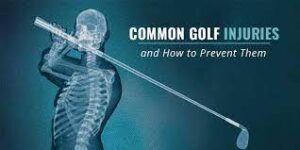Golf is a popular sport enjoyed by millions of people around the world. While golf is generally considered a low-impact sport, it’s not without its risks. Golfers can experience a variety of injuries, from minor strains and sprains to more serious injuries that require medical attention. In this article, we’ll take a closer look at the most common golf injuries and how to prevent them.
Golfers Elbow
Golfers elbow, also known as medial epicondylitis, is a common injury among golfers. It’s caused by repetitive stress on the tendons that attach to the inner elbow. Symptoms include pain and tenderness on the inner side of the elbow, as well as weakness in the grip.
To prevent golfers elbow, it’s important to warm up properly before playing. Stretching exercises that focus on the wrists, forearms, and elbows can help prevent injury. It’s also important to use proper technique when swinging, and to avoid overuse by taking breaks and practicing moderation.
Back Pain
Back pain is another common injury among golfers. The twisting motion of the golf swing can put stress on the lower back, leading to strains and sprains. Symptoms include pain in the lower back, muscle spasms, and difficulty moving.
To prevent back pain, it’s important to maintain good posture and core strength. Strengthening exercises that focus on the core muscles, such as planks and crunches, can help prevent injury. It’s also important to use proper technique when swinging, and to avoid overexertion by taking breaks and practicing moderation.
Shoulder Injuries
Shoulder injuries are common among golfers, particularly those who play frequently or with poor technique. The repetitive motion of the golf swing can put stress on the rotator cuff and other muscles in the shoulder, leading to strains and tears.
To prevent shoulder injuries, it’s important to warm up properly before playing. Stretching exercises that focus on the shoulders, as well as exercises that strengthen the rotator cuff, can help prevent injury. It’s also important to use proper technique when swinging, and to avoid overuse by taking breaks and practicing moderation.

Wrist Injuries
Wrist injuries can occur when the wrists are forced into an unnatural position during the golf swing. This can lead to strains, sprains, and even fractures. Symptoms include pain, swelling, and difficulty moving the wrist.
To prevent wrist injuries, it’s important to warm up properly before playing. Stretching exercises that focus on the wrists, as well as exercises that strengthen the forearm muscles, can help prevent injury. It’s also important to use proper technique when swinging, and to avoid overuse by taking breaks and practicing moderation.
Knee Injuries
Knee injuries can occur in golfers who have pre-existing knee problems, or in those who put excessive stress on their knees during the golf swing. Symptoms include pain, swelling, and difficulty moving the knee.
To prevent knee injuries, it’s important to maintain good posture and balance during the golf swing. Strengthening exercises that focus on the quadriceps and hamstrings can help prevent injury. It’s also important to use proper technique when swinging, and to avoid overuse by taking breaks and practicing moderation.
Golf is generally considered a low-impact sport, but it’s not without its risks. Golfers can experience a variety of injuries, from minor strains and sprains to more serious injuries that require medical attention. To prevent golf injuries, it’s important to warm up properly before playing, use proper technique when swinging, and avoid overuse by taking breaks and practicing moderation. With the right approach, golf can be a safe and enjoyable sport for people of all ages and skill levels.
It’s also important to note that golf injuries can be caused by a variety of factors, including age, previous injuries, and underlying medical conditions. If you experience pain or discomfort while playing golf, it’s important to seek medical attention to determine the cause of your symptoms and to receive appropriate treatment.

In addition to prevention
There are steps you can take to promote healing if you do experience a golf injury. Rest, ice, compression, and elevation (RICE) can help reduce swelling and pain. Over-the-counter pain relievers, such as ibuprofen or acetaminophen, can also help manage pain and inflammation.
Physical therapy can also be an effective way to treat golf injuries. A physical therapist can develop a customized exercise program to help you recover from your injury and prevent future injuries. They can also provide guidance on proper technique and form to reduce the risk of re-injury.
Golf injuries are a common occurrence among golfers, but they can be prevented with the right approach. By warming up properly, using proper technique, and practicing moderation, golfers can reduce the risk of injury and enjoy the sport safely. If you do experience a golf injury, seek medical attention and follow a treatment plan to promote healing and prevent future injuries. With the right approach, golf can be a safe, enjoyable, and healthy sport for people of all ages and skill levels.
It’s also worth noting that prevention is key when it comes to golf injuries. Here are some additional tips for preventing golf injuries:
Use proper equipment: Using clubs that are the right size and weight for your body can help prevent injuries. Make sure your clubs are properly fitted and in good condition.
Warm up before playing: Take a few minutes to stretch and warm up before playing. Focus on stretching the muscles used in the golf swing, such as the shoulders, back, and hips.
Use proper technique: Using proper technique when swinging can help reduce the risk of injury. Work with a golf pro to develop good form and to improve your swing.
Practice moderation: Avoid overuse by taking breaks and practicing moderation. Don’t play too many rounds in a row, and take breaks between shots to rest and recover.
Stay hydrated: Drinking plenty of water can help prevent cramps and muscle strains.
Listen to your body: If you experience pain or discomfort while playing golf, stop playing and seek medical attention. Ignoring pain can lead to more serious injuries and longer recovery times.
By following these tips, golfers can reduce the risk of injury and enjoy the sport safely. Golf is a great way to stay active and enjoy the outdoors, and with the right approach, it can be a safe and healthy sport for people of all ages and skill levels.


